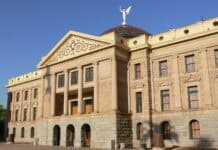The Sedona Fire District’s board unanimously approved a tentative budget of $23,842,812 and a 4% tax increase during its May 16 meeting. The final hearing on and adoption of the budget is scheduled for Tuesday, June 20.
The board proposed a mil rate of 2.703, meaning that residents would pay $2.703 for every $1,000 of their property’s assessed value, which works out to a 4.16% increase.
The tentative budget of $23.8 million is 10.38% higher than but similar to SFD’s fiscal year 2022- 23 budget of $21.6 million and is tailored to address inflation’s effects on SFD’s costs. As inflation moderates, SFD anticipates that the adjustment of the mil rate in the future will be less abrupt.
“Fortunately we over-budgeted [for fuel] because fuel prices dropped quicker than expected,” SFD Chief Ed Mezulis said. “We’re able to recognize some savings, but just like everybody, inflation has impacted everything that we do. We are also looking at ways to reduce costs, such as converting to LED lights. But it’s the supply chain that continues to be an issue for us.”
Last month, SFD ordered a new fire engine that will not be delivered for three years and is also facing a one-year wait time on water tenders due to supply chain issues. Since the district receives most of its funding from property taxes, the inability of assessed property values to keep pace with inflation has affected its financial situation as well.
The proposed personnel budget of $18.9 million is 85% of the total, but the proposed cost-of-living adjustment for SFD staff will not be sufficient to keep up with inflation. The board approved a maximum COLA of 6.5%. During SFD’s budget workshops, the inflation rate for Arizona was described as 8.5%. The firefighters’ union was seeking a 7% COLA.
SFD staff admit there is a need for a compensation study, but that will not begin until July, after other fire districts complete their budgets.
SFD revenues from the sale of recreational marijuana in Arizona increased to $210,000 and are not earmarked for any particular purpose.
About $1.6 million of the proposed budget is for capital improvements, particularly replacing much of the district’s communications equipment, which is reaching the end of its service life. The capital budget also includes funding for cardiac monitors, breathing air compressors and rescue airbags.
Year-to-date revenue for SFD was $20.4 million, which was $760,000 over budget, and YTD expenses were $16.2 million, which was $104,000 under budget as of April. “SFD is on target with its expenses and revenues for 2023,” the district’s April financial report stated.
Human Resources
The district’s legal costs have been moved from the fire board’s budget into the human resources section to better reflect how the money is being used. The human resource department has been working on conflict resolution and developing a task book for cross-training SFD staff.
SFD’s recent job announcement for firefighters elicited 26 applications, which Mezulis said was less than what he hoped to see for the three openings. He also noted that fewer applicants is a statewide trend. The hiring list is scheduled to be completed in August with a new hire academy anticipated in September.
The district has experienced an increased number of early retirements through the Deferred Retirement Option Plan, as many of the current staff were hired in the early 2000s. Staff changes have also reflected this trend, with all of SFD’s battalion chiefs being newly promoted, as well as a sizable number of its captains and engineers, Mezulis said.
“The deferred retirement option program came into play 15 years ago and it was driven by the law enforcement associations because everybody was leaving,” Mezulis said. “We’re back there again where we’re seeing a lot of the fire departments and districts in Arizona really grew in the early 2000s. And we’re at a reset point.”
Social Media
Social media’s effects on Sedona trails and SFD was also raised during the general meeting. There are claims that word-of mouth spread on the internet is driving foot traffic to public lands that do not have designated uses or have recreational trails not listed on U.S Forest Service maps, which is causing SFD to respond to medical incidents at areas such as Subway Cave in Boynton Canyon.
“It hasn’t impacted our ability to respond, but it has added a new dynamic,” Mezulis said. “Anytime a trail gets popular, people get hurt on it, then that’s a new spot for us to go grab people. [For] a few years, canyoneering became popular and so we had an uptick in canyoneering rescues.”
